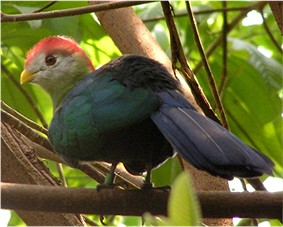Twenty two species of turaco inhabit central and southern Africa and, oddly for a continent with such a diversity of unique wildlife, they comprise the only family of birds limited in distribution to Africa. Many are spectacularly colored in glossy green, red and violet, and are lent some of these hues by pigments unknown in other birds. They bound from branch to branch, uttering odd, bark-like cries and flaring their characteristic head crests.
All turacos are largely frugivorous and, indeed, are one of the few birds known to feed fruit to their nestlings. The young are also unique in (along with the even stranger hoatzin) possessing claws at the wing joint that allow them to clamber about the branches.

The first turaco I had contact with was an Angolan Red-Crested (Tauraco erythrolophus), housed at the Bronx Zoo. As we know, hand-raised birds often imprint upon humans and mature into animals that, while good pets, behave somewhat abnormally. I have related previously the tale of a Great Horned Owl that attempted to “court” his keepers by attempting to stuff mice into our mouths. Zoos seeking to release hand-reared birds back to the wild, as has been done with California Condors, utilize hand puppets when feeding the nestlings to prevent imprinting.
Well, the turaco in question, christened “Bloody Mary” for the cuts she left about the head and ears of anyone entering her exhibit, took a differen t view of “imprinting”. Even when tossed away (gently, of course!), she would fly back and attack, so much so that keepers took to wearing hard hats when feeding her. She was equally aggressive to other birds, forcing me to install an opaque barrier between her cage and her neighbors, in order to give them some peace. The accompanying photograph shows my friend not seeking a treat or a scratch on the head, but an opportunity to peck at whatever part of me presents itself!
t view of “imprinting”. Even when tossed away (gently, of course!), she would fly back and attack, so much so that keepers took to wearing hard hats when feeding her. She was equally aggressive to other birds, forcing me to install an opaque barrier between her cage and her neighbors, in order to give them some peace. The accompanying photograph shows my friend not seeking a treat or a scratch on the head, but an opportunity to peck at whatever part of me presents itself!
Bloody Mary aside, turacos make spectacular additions to the collections of advanced hobbyists, but they do need a huge flight cage.
You can read about the care of Red Crested Turacos at Cotswold Wildlife Park, and view photos, at:
 That Bird Blog – Bird Care and History for Pet Birds
That Bird Blog – Bird Care and History for Pet Birds


